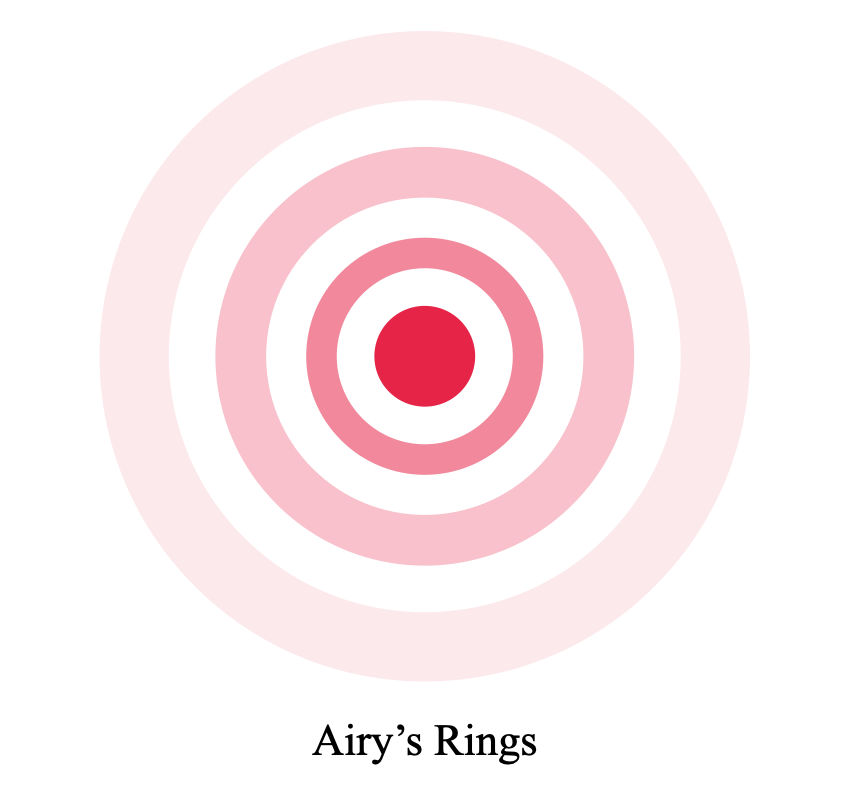
Define the resolving power of microscopes. Write its formula. How will it vary, when
(a) wavelength of incident light is decreased.
(b) the aperture of the objective lens is decreased.
Answer
581.7k+ views
Hint: Microscopes are used to see objects which are too small for naked eye. We use circular openings like lenses to magnify the object. Whenever we use a circular opening like a lens or iris of our eye. A circular diffraction pattern is formed. We need to differentiate between two such diffraction patterns which are very close to each other. The resolving power of a microscope gives us that limit.
Complete step by step solution:
Resolving power of microscopes is given by the inverse of the distance between two lines or points that can be resolved clearly using the microscope.
Let’s understand why we need this quantity. When we see an object through a circular opening it creates a diffraction pattern as shown in the following figure. The concentric rings are called Airy’s rings.

When two objects are very close to each other, we need to make sure that these rings do not overlap with each other and create a blurry image of the two objects. This gave rise to the Rayleigh criterion.
We can use this criterion to find the resolving power of microscopes. It is given by the inverse of the distance between two objects that can be resolved. Hence, we can write the Abbe’s criterion as,
$\text{Resolving power = }\dfrac{1}{\Delta d}=\dfrac{2n\sin \theta }{\lambda }$
Where,
$\dfrac{1}{\Delta d}$ is the resolving power of the microscope
$n$ is the refractive index separating the object and aperture.
$\lambda $is the wavelength of the light used for observation.
The term$n\sin \theta $ is also called Numerical Aperture (N.A.) of the microscope. Hence, we can write,
$\text{Resolving power = }\dfrac{1}{\Delta d}=\dfrac{2\text{N}\text{.A}\text{.}}{\lambda }$.................(1)
(a) From equation (1) we can say that the resolving power of the microscope will increase if the wavelength of incident light is decreased.
(b) From equation (1) we can again say that the resolving power of the microscope will decrease if we decrease the aperture of the objective lens.
Note: Rayleigh’s criterion is given by,
$\theta =1.22\dfrac{\lambda }{d}$
Where,
$\theta $ is the half angle subtended by the first minimum at the source
$\lambda $ is the wavelength of light that is being used for measurement
$d$ is the distance between the two objects
This is an important criterion to observe two fully resolved objects using telescopes or microscopes.
Complete step by step solution:
Resolving power of microscopes is given by the inverse of the distance between two lines or points that can be resolved clearly using the microscope.
Let’s understand why we need this quantity. When we see an object through a circular opening it creates a diffraction pattern as shown in the following figure. The concentric rings are called Airy’s rings.

When two objects are very close to each other, we need to make sure that these rings do not overlap with each other and create a blurry image of the two objects. This gave rise to the Rayleigh criterion.
We can use this criterion to find the resolving power of microscopes. It is given by the inverse of the distance between two objects that can be resolved. Hence, we can write the Abbe’s criterion as,
$\text{Resolving power = }\dfrac{1}{\Delta d}=\dfrac{2n\sin \theta }{\lambda }$
Where,
$\dfrac{1}{\Delta d}$ is the resolving power of the microscope
$n$ is the refractive index separating the object and aperture.
$\lambda $is the wavelength of the light used for observation.
The term$n\sin \theta $ is also called Numerical Aperture (N.A.) of the microscope. Hence, we can write,
$\text{Resolving power = }\dfrac{1}{\Delta d}=\dfrac{2\text{N}\text{.A}\text{.}}{\lambda }$.................(1)
(a) From equation (1) we can say that the resolving power of the microscope will increase if the wavelength of incident light is decreased.
(b) From equation (1) we can again say that the resolving power of the microscope will decrease if we decrease the aperture of the objective lens.
Note: Rayleigh’s criterion is given by,
$\theta =1.22\dfrac{\lambda }{d}$
Where,
$\theta $ is the half angle subtended by the first minimum at the source
$\lambda $ is the wavelength of light that is being used for measurement
$d$ is the distance between the two objects
This is an important criterion to observe two fully resolved objects using telescopes or microscopes.
Recently Updated Pages
Master Class 12 Business Studies: Engaging Questions & Answers for Success

Master Class 12 Economics: Engaging Questions & Answers for Success

Master Class 12 English: Engaging Questions & Answers for Success

Master Class 12 Maths: Engaging Questions & Answers for Success

Master Class 12 Social Science: Engaging Questions & Answers for Success

Master Class 12 Chemistry: Engaging Questions & Answers for Success

Trending doubts
What are the major means of transport Explain each class 12 social science CBSE

Which are the Top 10 Largest Countries of the World?

Draw a labelled sketch of the human eye class 12 physics CBSE

How much time does it take to bleed after eating p class 12 biology CBSE

Explain sex determination in humans with line diag class 12 biology CBSE

Differentiate between homogeneous and heterogeneous class 12 chemistry CBSE




